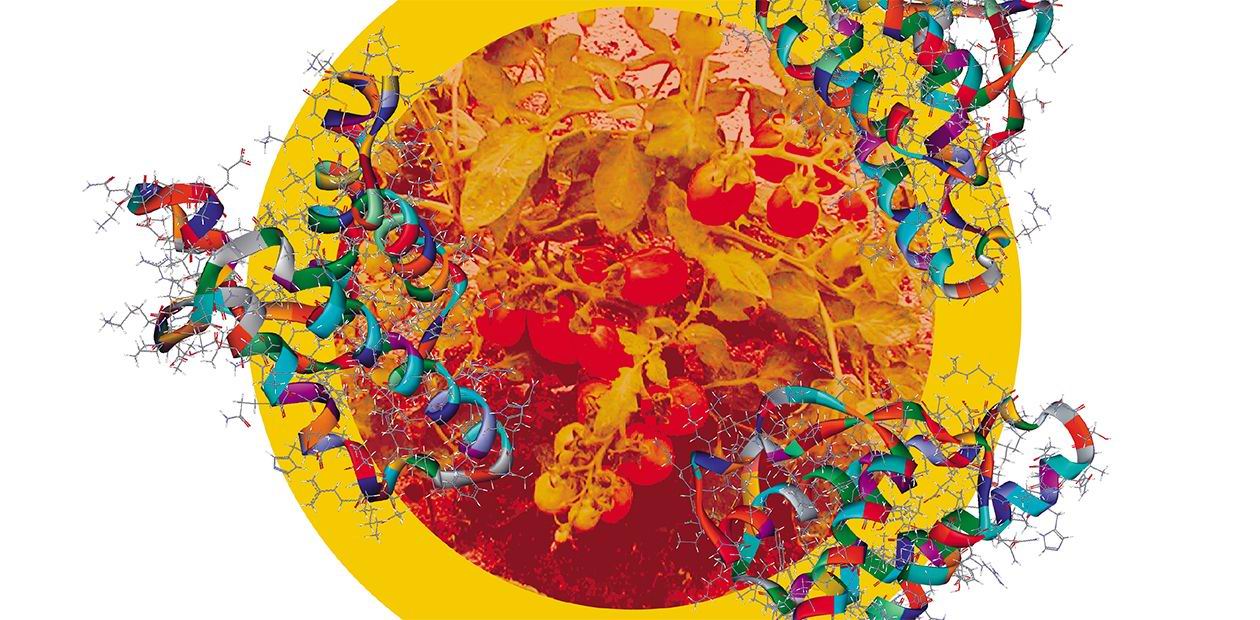Tomorrow's Vaccines
We need food as plants need light. Food gives us energy for thinking and doing and supplies building blocks to our muscles, bones, and nerves. Food can please our taste, touch, smell, and even our sense of beauty. The food of the new age has every prospect to take on a new quality of protecting our health and to become working rather than just savory and feeding. Meet edible vaccines!
An event that occurred in May 1796 valued millions of saved human lives. Edward Jenner, an English doctor, discovered that people can be protected against the dreadful natural smallpox if infected with cowpox or vaccine (from vaccus, the Latin for cow), a similar mild disease. Less than a century later Louis Pasteur took up with his plentiful discoveries. Since then vaccination has become the most popular, efficient and accessible measure against diseases caused by pathogenic microbial organisms, especially against viruses which are stubbornly resistant to pharmacological treatment.
Vaccination consists in introducing killed or weak microbes into the human organism to trigger its immunity or resistance to diseases in response to antigens (protein, polysaccharide, or other molecules) carried by the pathogenic agents and identified by the organism. The first vaccines were obtained by trial and error while today’s advance in molecular biology and recombinant DNA technology offers excellent opportunities for developing new ways of vaccination and new vaccines.
The new vaccines are produced using plasmid-based DNA constraints or are micro-capsulated and ‘candy’ varieties with trehalose carbohydrate, or are based on synthetic proteins and polysaccharides, etc. These vaccines are commonly required to be safe, cheap, simple in use, and to stand long storage and transport without chilling machinery. All these requirements are perfectly met by gene modified (GM) plants bearing spliced DNAs of pathogenic microbes, and their use can become a breakthrough in preventive medicine.
Having eaten and fine!
What are the advantages and specialties of edible vaccines? First, the very way of oral immunization is easy, handy, and safe as it runs lower risks of additional infections than the skin-through injections or scarification. Second, the eaten vaccine goes right into the alimentary tract, or specifically into its mucosal membranes.
The mucosal membranes of the alimentary, respiratory, and urogenital tracts are the most common places where many pathogens penetrate and colonize. These membranes are protected by immune cells arranged in special lymphoid tissues. The mucosal immune system is the first barrier on the way of infections, whereas the systematic immune system known from earlier times protects the inner organs.
The stimulation of humoral immunity by injection vaccination is usually efficient against the systematic infections but does not protect the mucose membranes while the mucose immunization most often triggers both the mucose and systematic responses.
Direct vaccination via mucosal membranes is poorly efficient because of physiological blocks against antigens. However, antigens protected by vegetal coating safely pass through the aggressive medium of gullet and stomach to reach the bowels and, hence, the mucosal immune system.
The plant vaccines are attractive not only because they are cheap and handy in storage and in use but also because the scope of their food prototypes is extremely extensive, including various vegetables, fruit, and cereals. Moreover, it is possible to create plant producers of antigens to multiple agents, i.e. edible multi-component vaccines! Who knows, perhaps, this was the ideal foreseen by the pioneers of vaccination over two centuries ago?
Stuffed tomatoes
The very idea of transgenic plant vaccine was put forward by Hugh Mason in 1992. Three years later a vaccine against B hepatitis was successfully obtained on the basis of transgenic tobacco which synthesized the surface antigen of the (HBsAg) virus. When injected to mice, the recombinant protein extracted from tobacco caused the same specific response as the standard transgenic yeast vaccine. The medicinal transgenic tobacco was followed by GM potatoes producing HBsAg, and tests on volunteers since 1999 have shown positive results.
The use of plants which need no cooking has become lately an essential and promising line of research. Scientists from the “Vector” Federal Science Center for Virology and Biotechnology (Koltsovo, Novosbirsk region) in cooperation with people from the Siberian Institute of Plants Physiology and Biochemistry (Irkutsk) and the Institute of Chemical Biology and Basic Medicine (Novosibirsk) are developing candidate edible vaccines against the human B hepatitis and human AIDS viruses on the basis of transgenic tomatoes. The project received a support from the US Ministry of Agriculture (grant No 2176p from the International Science and Technology Center).
The ill-fame AIDS and B hepatitis viruses are known without advertising. Their propagation in today’s world has become epidemic and the annual death rate reaches 2-3 mln people from AIDS and 1 mln from hepatitis (WHO data). No wonder that these diseases are the focus of attention of biotechnologists worldwide.
Designing a chimer
There are several approaches to designing recombinant vaccines. One approach implies splicing a real gene of the infection agent. Less usual and more promising is to handle the genes that encode synthetic proteins, or synthetic vaccines. These are molecules with a pre-specified tertiary structure and an optimum composition of epitopes, the active centers of the infection antigen that trigger chain immune reactions in the organism.
Applying the latter approach, A.M. Eroshkin and his colleagues from “Vector” modeled the anti-AIDS multi-determinant immunogenic protein called TBI (T- and B-cellular immunogen). Then the respective encoding DNA was synthesized and inserted into coli bacillus E. coli. Animals immunized by the resulting recombinant protein showed both humoral and cellular immune responses against the AIDS virus, which validated the chosen approach.
The researchers went on towards the development of edible vaccines. They decided to insert their constraint into tomato plants and to make them synthesize the ‘non-natural’ protein. It is a synthetic and also a chimeric protein, as the collection of nine TBI epitopes was extended with a surface hepatitis antigen (HBsAg) to obtain a multi-component synthetic vaccine active against both infections. The chimeric constraints were designed by scientists from “Vector” and the Institute of Chemical Biology and Basic Medicine (Novosibirsk) and were transferred to plants; the subsequent plant selection was carried out by specialists from the Siberian Institute of Plants Physiology and Biochemistry (Irkutsk).
The price of ‘golden apples’
The presence of the TBI and HBsAg antigen determinants in the leaves and fruit of the selected transgenic plants confirmed the synthesis of the target chimeric protein TBI-HBsAg. To avoid errors, the protein was determined independently at the Institute of Plants Physiology and Biochemistry (Irkutsk) and at the “Vector” Center. The question is whether these nice transgenic tomatoes will really work as vaccine and merit their Italian name golden apples (tomato in Italian is pomodoro, from pomo d’oro or golden apple).
There is one important thing concerning testing the new vaccines. Vaccine is not a drug but only a preventive measure. How to test its effect if the diseases are serious or even fatal? Hardly shall we follow Jenner, who tested his discovery on his little son. Indeed, nobody would ever offer tomatoes to volunteers (if any), inoculate them against AIDS, and see what happens.
Therefore they were mice who faced the ‘combat’. Although mice never suffer from AIDS or hepatitis, their immune system was expected to respond to the antigen protein. Neither do they like tomatoes, and the pureed fruit was let into the mice’s gullet through a catheter. The immunity response was assessed by the standard enzyme immunoassay for the anti-AIDS and anti-hepatitis antibodies.
The experiment in which mice were fed with tomatoes three times every two weeks ended only in September 2004 and was definitely successful. Already after the second meal the animals developed anti-hepatitis antibodies. Moreover, the immune response started as early as after the first feeding, judging by the test of mice’s feces, and held over till the end of the experiment. For AIDS the results were similar. The antibody titer, though not very high, was stably different from the tests of the control group kept on the regular non-transgenic tomato ‘diet’.
Therefore, the candidate edible vaccine active against both the AIDS and B hepatitis infections has been obtained in principle. The work done is, however, just the top of an iceberg, as is clear from saying in principle and candidate.
The scientists involved in the project would like to continue with other transgene carriers, such as carrot, bell-pepper, or cereals, and to join their efforts with people from other cities and laboratories. Other challenging objectives are to increase the production of plant vaccines by modifying also the DNAs of numerous photosynthetic chloroplasts and to check the combination of an edible vaccine with injection of plasmid DNA vaccines, which appears promising according to preliminary results. To proceed from the indirect to direct clinical tests of the GM tomato vaccine, say, on primates is the most interesting and most difficult task: Growing bananas in Siberia is too expensive, leaving aside the price of monkeys…
Yet, whatever Russian scientists plan they’ve been having trouble with raising money. The future is vague so far. Further work requires at least $ 200,000 annually. Is this anyhow comparable to the daily expenses of the Center for AIDS near Washington?












